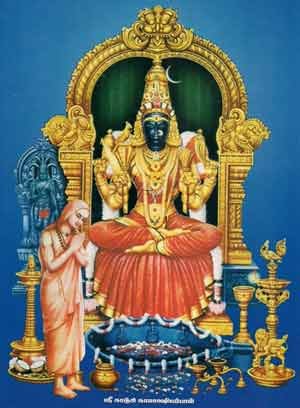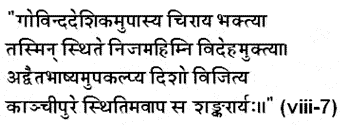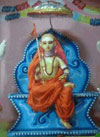Adi Shankaracharya & His Connection with Kanchipuram
A book By Sri A. Kuppuswami, B.A., B.T.
|
SRI SHANKARACHARYA AND HIS CONNECTION WITH KANCHIPURAM |
|
 |
CHAPTER-5 Bhagavatpada Sankara repaired to Kanchi,the southern Moksapuri, towards the end of his earthly career. A number of works speak of this fact. (1) Anandagiri’s biography of Sankara (all versions printed manuscripts, including the Madras University Edition), has:- |
(Therefore, the World Preceptor(Sankara), desiring to leave for his own abode, sitting once in the Moksapuri of Kanchi, having absorbed the gross physical frame into the subtle one, turninginto the shape of a thumb, attained eternal bliss and remains as the allpervading ‘Cit’ to this day). (2) The concluding verse ofRajacudamani Diksita’s Sankarabhyudaya’, refers to Sankara's worshipping Kamesvari(Kamakshi) every day attaining supreme bliss:-  (3) The ancient and voluminouswork, ‘Sivarahasya’, gives a brief sketch of the Acharya's life in the 16thchapter of the ninth section. This workhas been published as NO.32 in the Jayachamarajendra Granthamala Series, inCanarese script, with translation in Kannada language. Besides, manuscript copies of the work areavailable in many of the manuscript libraries of India, such as the OrientalManuscripts Library at Baroda, the Government Oriental Manuscripts Library,Madras, the Adyar Library, Madras, the Sarasvati Mahal Library at Thanjavuretc. The pertinent lines found below purport to state that Sankara came to theearth in haste after obtaining the five sphatika Lingas- Yoga. Bhoga, Vara, Mukti and Moksa; vanquishedBuddhist, Jain and other scholars and attained Siddhi (eternal bliss) at hisown asrama at Kanchi.  4) Markandeya Samhita, an ancient puranic treatise consists of 100 Khandas, each having subsections, called parispandas. Sub – sections 7 and 8 of the 72nd Khanda of this worknarrate briefly the history of Sankara. This is evident from the colophon at the end of the 7thparispanda of the 72nd Khanda, as noticed in the DescriptiveCatalogue of Sanskrit Manuscripts, volume VI of the Oriental ResearchInstitute, University of Mysore, 1981 – page 191 (Appendix – I -332, SerialNo.18179, Ms.No.P.3387/1 – title: ‘Sankaracaritam’). The colophon reads:- A verse in the seventh parispanda of the72nd khanda of this work relates that the Mahatma, Sankara, attainedthe cisvarupa, i.e. attained eternal bliss, at Kanchi after having consecratedKamakshi and ordaining Suresvara for the worship of the ‘Srividya raja – Pitha.’ Theverse indicating Sankara’s leaving off his mortal coils at Kanchi reads asfollows:-  ‘Patanjali Vijayam’, byRamabhadra Diksita (Kavyamala series No.51, Nirnaya Sagar Press, Bombay), hasthe following verse:-  Theseabove verse indicates that Sankara, after having produced the Bhasyas andconquered the directions(digvijaya), stayed permanently at Kanchi. (6) A Report on Search forSanskrit Manuscripts in South India, by Dr. Hultzch, a German scholar,(published by the Government Press, Madras, in 1908 – No.2146 – Part III),contains a list of pontifical preceptors of the BHarati ascetic order of theTungabhadra region. Some verses arefound in this list about Adi Shankaracharya. The verse quoted below related that, after travelling widely, Sankarareached Kanchi of his own accord, consecrated Kamakshi and attained finalbeautitude at Kanchi itself. The versereads thus:-  (7) The Guruparampara Namamala of the Sankarite Institution at the confluence of the rivers, Tunga and Bhadra (Kudali), also speaks of the Great Acharya’s reaching Kanchi after long and wide travels, of his own desire, the consecration of Devi Kamakshi and his Siddhi there, in the verse found below:  Coming to modern times, there is quite a large number of works, in different languages, by erudite scholars mentioningKanchi as the last resort of Sankara. (8) The Bengali Visvakosa (Hindi Edition), anencyclopaedia, gives the following information under the word ‘Kanchi’:-  The above Hindi passage notes Kanchi asthe place where Sankara attained Siddhi. (9) Pandit Mahamahopadhyaya Gopinath Kaviraj(Padma Vibhushan) in his ‘Bharatiya Samskriti aur Sadhana’, (in Hindi), has stated that the temple of Kamakshi at Kanchi is famous and in that temple there is the stone icon of Sankara and that spot is the place where he attained siddhi. The passage reads:-  Dr.S.K.Belvalkar says “…According to one set of traditions Kanchi in South Indiais given as the place where the Acharya (Shankaracharya) breathed his last. According to other sources, he died atBadarikasrama (Kedaranath) disappearing in a cave in the Himalayas. The weight of probablility belongs to thefirst view.” (Page 240, Gopal BasuMallik Lectures, by Dr.S.K.Belvalkar, Poona, 1929).
Pandit N. Bhashyacharya (ofMadras) in his ‘Age of Shankaracharya(Adyar Library, Madras – 1980 A.D. – page22), says”Lastly towards the end of his life he came to the south but had toleave his body and this world at Conjeevaram at the early age of thirty two.”
It needs mention that, in the Srimukha Birudavali (the string of honorific epithets) of Shankaracharya Mutt and Kanchi existing without change from very ancient times – the following epithet is found:-
 Some forty years ago, an imageof Adya Sankara was installed at Kedarnath by the Head of the Dvaraka Matha. Prominent among those who were instrumental in the erection of this memorial at Kedarnath was late Dr.Sampurnanand, the then Chief Minister of Uttar Pradesh. His views regarding the place where Sankara attained eternal bliss were made clear in a letter by him to Dr.T.N.Ramachandran(late Joint Director of Archaeology, Government of India). The letter was dated 6th July 1958. Among the contents of the letters, the following is worth perusing:- “Recently, I had occasion to discuss the matter with the Shankaracharya of Dvaraka Pitha also. In the first place, the word ‘samadhi’, (atKedarnath), is a misnomer in this connection. There is nothing to prove that Shri Shankaracharya died at this spot.” About a year after the abovementioned letter of Dr. Sampurnanand, aprominent Sadhu of Kerala, Sri Sahajananda of Guruvayur, in his letter (published in the 'Hindu' dated 16th June 1959) has stated “On enquiry at Joshi Matha, they say it (the memorial at Kedarnath) is only a sankalpasamadhi and the actual Samadhi is not at that spot.” |
|
| Book Index Page |  |
CHAPTER6 Shankaracharya Sculptures in Kanchi |
Back to Page - Focus Adi Shankaracharya
